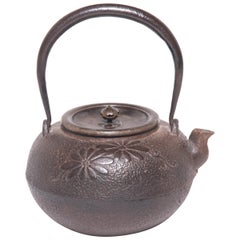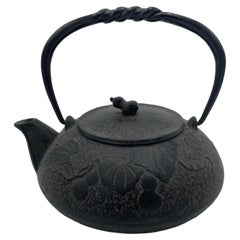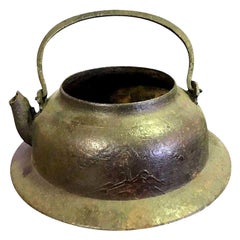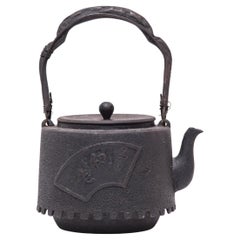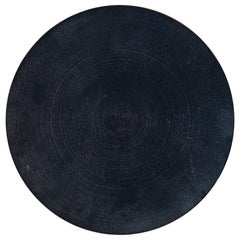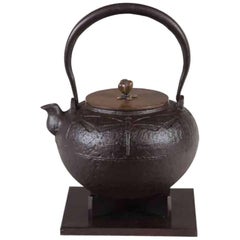Japanese Iron Tetsubin
Japanese Iron Tetsubin with Chrysanthemum Blossoms, c. 1900
Located in Chicago, IL
Japanese teapot was used to boil water for traditional tea ceremonies. Known as tetsubin, the kettle’s cast
Category
Early 20th Century Japanese Meiji Metalwork
Materials
Bronze, Iron
Antique Japanese Kettle with Iron Tetsubin : Calabash Design 1930s
Located in Paris, FR
this item are called 'Tetsubin' in Japan.
It can be put on the fire or an induction plate. Also we can
Category
Vintage 1930s Japanese Tea Sets
Materials
Iron
Japanese Cast Iron Tea Kettle Water Pot Tetsubin, Late 19th Century
Located in Studio City, CA
A large, heavy and uniquely shaped Japanese cast iron teapot tetsubin without top.
Likely late
Category
Antique Late 19th Century Japanese Meiji Metalwork
Materials
Iron
“Fanning the Fire” Japanese Tetsubin Kettle, c. 1924
Located in Chicago, IL
tea ceremonies. Known as tetsubin, the kettle’s cast-iron construction is said to change the quality
Category
Early 20th Century Japanese Taisho Metalwork
Materials
Iron
Recent Sales
Modernist Japanese Tetsubin Low Iron Bowl, 1960s
Located in San Diego, CA
Modernist Japanese Tetsubin low iron bowl. Solid iron with a nice patina. Made in Japan label on
Category
Mid-20th Century Japanese Mid-Century Modern Decorative Bowls
Materials
Iron
Tetsubin Iron Bronze Brown Water Kettle Japan Meiji Dragonfly Motif
Located in Monterey, CA
Taisho period circa 1920.
Tetsubin (鉄瓶) are Japanese cast-iron kettles with a pouring spout, a lid, and
Category
Antique Late 19th Century Japanese Meiji Jars
Materials
Bronze, Iron
Tetsubin Iron Bronze Brown Kettle Japan Meiji Wood Grain Pattern Solid Handle
Located in Monterey, CA
This Japanese Tetsubin has a wood Grain Pattern with Iron Lid and Solid Moku-Tsuru Iron Handle. The
Category
Antique Late 19th Century Japanese Meiji Jars
Materials
Bronze, Iron
Tetsubin Iron Bronze Brown Water Kettle Japan Meiji Ruyundo Ihada Texture Signed
Located in Monterey, CA
This Japanese Tetsubin has a signed Lid, Ruybundo, Ihada Texture with Iron Lid and Hollow
Category
Antique Late 19th Century Japanese Meiji Jars
Materials
Bronze, Iron
H 8.25 in Dm 6.25 in
Tetsubin Iron Bronze Brown Kettle Japan Meiji Floral Flower Motif Bas-Relief
Located in Monterey, CA
This Japanese Tetsubin has a Floral Motif in Bas-Relief with Bronze Lid and Hollow Fukurobari Iron
Category
Antique Late 19th Century Japanese Meiji Jars
Materials
Bronze, Iron
Tetsubin Iron Bronze Brown Water Kettle Japan Meiji Ruyundo Ihada Texture Signed
Located in Monterey, CA
the Taisho period circa 1920.
Tetsubin (鉄瓶) are Japanese cast-iron kettles with a pouring spout, a
Category
Antique Late 19th Century Japanese Meiji Jars
Materials
Bronze, Iron
Antique Japanese Kettle with Iron Tetsubin 1930s
Located in Paris, FR
This kettle was made in 1930s, in Showa era.
The iron kettles like this item are called 'Tetsubin
Category
Vintage 1930s Japanese Tea Sets
Materials
Iron
Japanese Tetsubin with Wado Kaichin Coin
Located in Chicago, IL
traditional tea ceremonies. Known as tetsubin, the kettle’s cast-iron construction is said to change the
Category
Early 20th Century Japanese Meiji Metalwork
Materials
Bronze, Iron
Japanese Tetsubin with Peach Blossom and Fruit
Located in Chicago, IL
boil water for traditional tea ceremonies. Known as tetsubin, the kettle’s cast-iron construction is
Category
Early 20th Century Japanese Metalwork
Materials
Iron
Collection of Six Japanese Tetsubin/Sake Pots
Located in Chicago, IL
A collection of six 19th century Japanese cast iron pots (four for boiling water, and a pair for
Category
Antique 19th Century Japanese Tea Sets
Materials
Iron, Bronze
Japanese Tetsubin with Woven Texture, c. 1900
Located in Chicago, IL
traditional tea ceremonies. Known as tetsubin, the kettle’s cast-iron construction is said to change the
Category
Early 20th Century Japanese Meiji Metalwork
Materials
Bronze, Iron
Japanese Meiji Cast Iron Floral Tea Kettle Water Pot Tetsubin, Late 19th Century
Located in Studio City, CA
A fairly large, heavy, and uniquely shaped Japanese cast iron teapot tetsubin decorated with a
Category
Early 20th Century Japanese Meiji Metalwork
Materials
Iron
Japanese Ornate Floral Cast Iron Tea Kettle Water Pot Tetsubin Late 19th Century
Located in Studio City, CA
A wonderfully decorated with natural floral patterns, fairly heavy Japanese cast iron teapot
Category
Early 20th Century Japanese Showa Metalwork
Materials
Iron
Textured Japanese Tetsubin Teapot with Lotus Bud Knob, c. 1900
Located in Chicago, IL
used to boil water for traditional tea ceremonies. Known as tetsubin, the kettle’s cast-iron
Category
Early 20th Century Japanese Meiji Metalwork
Materials
Bronze, Iron
Japanese Iron Tetsubin with Red Lacquer Lid, c. 1900
Located in Chicago, IL
used to boil water for traditional tea ceremonies. Known as tetsubin, the kettle’s cast-iron
Category
Early 20th Century Japanese Meiji Antiquities
Materials
Iron
"Iron Bamboo" Flared Japanese Tetsubin Kettle
Located in Chicago, IL
Known as “tetsubin,” cast-iron kettles have been produced in Japan for centuries. Made to boil
Category
Early 20th Century Japanese Metalwork
Materials
Iron
Antique Japanese Cast Iron Tea Pot or Tetsubin
Located in Miami, FL
Vintage Tetsubin Japanese iron kettle in perfect antique condition. It would make a great display
Category
20th Century Japanese Tea Sets
Materials
Iron
Antique Japanese Cast Iron Tea Pot or Tetsubin
Located in Miami, FL
Vintage Tetsubin Japanese iron kettle in perfect antique condition. It would make a great display
Category
20th Century Japanese Tea Sets
Materials
Iron
Japanese Cast Iron Tetsubin with Poetic Landscape, c. 1900
Located in Chicago, IL
traditional tea ceremonies. Known as tetsubin, the kettle’s cast-iron construction is said to change the
Category
Early 20th Century Japanese Meiji Metalwork
Materials
Iron
Vintage Japanese Cast Iron Tetsubin Teapot with Floral Relief Pattern
Located in West Hollywood, CA
This exquisite vintage Japanese cast iron Tetsubin teapot showcases a beautifully embossed floral
Category
Mid-20th Century Japanese Rustic Tea Sets
Materials
Iron
Early 20th Century Textured Japanese Tetsubin
Located in Chicago, IL
was used to boil water for traditional tea ceremonies. Known as tetsubin, the kettle’s cast-iron
Category
Early 20th Century Japanese Meiji Metalwork
Materials
Bronze, Iron
Japanese Meiji Tetsubin with Sansui Landscape
Located in Chicago, IL
was used to boil water for traditional tea ceremonies. Known as tetsubin, the kettle’s cast iron
Category
Antique Late 19th Century Japanese Meiji Tea Sets
Materials
Iron
Japanese Edo Period Iron Tetsubin Tea Pot Kettle with Turtle Motif Decoration
Located in Studio City, CA
This is a truly rare and uniquely decorated and designed Edo period tetsubin. The detail and
Category
Antique 19th Century Japanese Edo Metalwork
Materials
Iron
H 10.25 in W 9 in D 8 in
Early 20th Century Japanese Tetsubin Tea Pot, Cast Iron and Brass, Meiji Period
Located in Los Angeles, CA
Japanese tea pot known as "tetsubin", the kettle’s cast-iron construction is said to change the
Category
Antique Early 19th Century Japanese Meiji Tea Sets
Materials
Brass, Iron
Japanese Fine Hand Cast Samurai HORSE Theme Tea Pot Tetsubin Immediately Useable
Located in South Burlington, VT
Here's a finely cast traditional iron teapot -tetsubin- with a deep relief samurai horse carving
Category
Mid-20th Century Japanese Showa Scholar's Objects
Materials
Iron
H 8 in W 6.5 in D 6.5 in
Tetsubin with Gilt Lacquered Top
Located in Chicago, IL
Chinese artisans often weave stories and symbolism into their furniture designs. This coffer has eight drawers because the Mandarin word for “eight” sounds likes the word for prosper...
Category
Antique Mid-19th Century Japanese Metalwork
Materials
Iron
Japanese Fine Hand Cast Crab and Shells Theme Tea Pot Tetsubin, Signed 1930s
Located in South Burlington, VT
From our most recent Japanese Kyoto Acquisitions
Here's a finely cast traditional iron teapot
Category
Vintage 1930s Japanese Showa Sculptures and Carvings
Materials
Silver, Iron
Japanese Iron Teapot
Located in Pasadena, CA
This is a good example of an early to mid-20th century Japanese iron teapot. This Tetsubin or tea
Category
Early 20th Century Japanese Japonisme Tea Sets
Materials
Iron
Tetsubin Iron Bronze Brown Water Kettle Japan Meiji
Located in Monterey, CA
Taisho period circa 1920. T
Tetsubin (鉄瓶) are Japanese cast-iron kettles with a pouring spout, a lid
Category
Antique Late 19th Century Japanese Meiji Jars
Materials
Silver, Bronze, Iron
Tetsubin Iron Bronze Brown Kettle Japan Meiji Dragon Bas-Relief Signed
Located in Monterey, CA
period circa 1890 to the Taisho period circa 1920.
Tetsubin (鉄瓶) are Japanese cast-iron kettles with a
Category
Antique Late 19th Century Japanese Meiji Jars
Materials
Bronze, Iron
Tetsubin Iron Bronze Brown Water Kettle Japan Meiji Signed Snow Pattern
Located in Monterey, CA
circa 1890 to the Taisho period circa 1920.
Tetsubin (鉄瓶) are Japanese cast-iron kettles with a
Category
Antique Late 19th Century Japanese Meiji Jars
Materials
Bronze, Iron
Japanese Iron Tetsubin Teapot with Cloisonné Lid
Located in Salt Lake City, UT
This Japanese "tetsubin" teapot--decorated with an attractive uniform dotted surface, a cloisonné
Category
Early 20th Century Japanese Meiji Metalwork
Materials
Iron
Antique Japanese Tetsubin Signed Bronze and Cast Iron Tea Pot Kettle
Located in Atlanta, GA
An antique Asian, probably Japanese in origin, cast iron and bronze Tetsubin. This piece has a
Category
Early 20th Century Japanese Japonisme Metalwork
Materials
Metal, Bronze
People Also Browsed
Mid-20th Century, Showa, Japanese Steel Teapot
Located in Sampantawong, TH
Japanese steel teapot with nice design.
Age: Japan, Showa Period, Mid-20th Century
Size: Height 20.8 C.M. / Width 21 C.M.
Condition: Nice condition overall.
Category
Mid-20th Century Japanese Metalwork
Materials
Metal
19th Century, Meiji, Antique Japanese Iron Teapot with Bronze Lid
Located in Sampantawong, TH
Antique Japanese iron teapot with bronze lid.
Age: Japan, Meiji Period, 19th Century
Size: Height 19.8 C.M. / Width 17.3 C.M. / Diameter 15.5
Condition: Nice condition overall.
10...
Category
Antique 19th Century Japanese Antiquities
Materials
Bronze, Iron
$1,000 Sale Price
20% Off
H 7.8 in W 6.82 in D 6.11 in
19th Century, Meiji, Antique Japanese Iron Teapot with Artist Sign
Located in Sampantawong, TH
Japanese iron teapot with artist sign.
Age: Japan, Meiji Period, 19th Century
Size: height 24.3 cm / width 16 cm
Condition: Nice condition overall.
100% Satisfaction and aut...
Category
Antique 19th Century Japanese Antiquities
Materials
Iron
$2,560 Sale Price
20% Off
H 9.57 in W 6.3 in D 5.52 in
Get Updated with New Arrivals
Save "Japanese Iron Tetsubin", and we’ll notify you when there are new listings in this category.
Japanese Iron Tetsubin For Sale on 1stDibs
Find many varieties of an authentic Japanese iron tetsubin available at 1stDibs. A Japanese iron tetsubin — often made from iron, metal and bronze — can elevate any home. Whether you’re looking for an older or newer Japanese iron tetsubin, there are earlier versions available from the 19th Century and newer variations made as recently as the 20th Century. A Japanese iron tetsubin, designed in the style, is generally a popular piece of furniture.
How Much is a Japanese Iron Tetsubin?
Prices for a Japanese iron tetsubin start at $389 and top out at $4,080 with the average selling for $880.
More Ways To Browse
Okimono Crab
Sake Pot
Antique Cast Iron Pot With Lid
Cast Iron Teapot
Japanese Cast Iron Vase
Jade Teapot
Cast Iron Kettle Pot
Iron Crab
Cast Iron Tea Kettle
Cast Iron Tea Pot
Japanese Cast Iron Teapot
Japanese Tetsubin
Crab Pot
Antique Japanese Cast Iron Teapot
Antique Tetsubin
Japanese Copper Kettle
Japanese Bronze Bonsai Planter
Japanese Bronze Crane And Turtle
